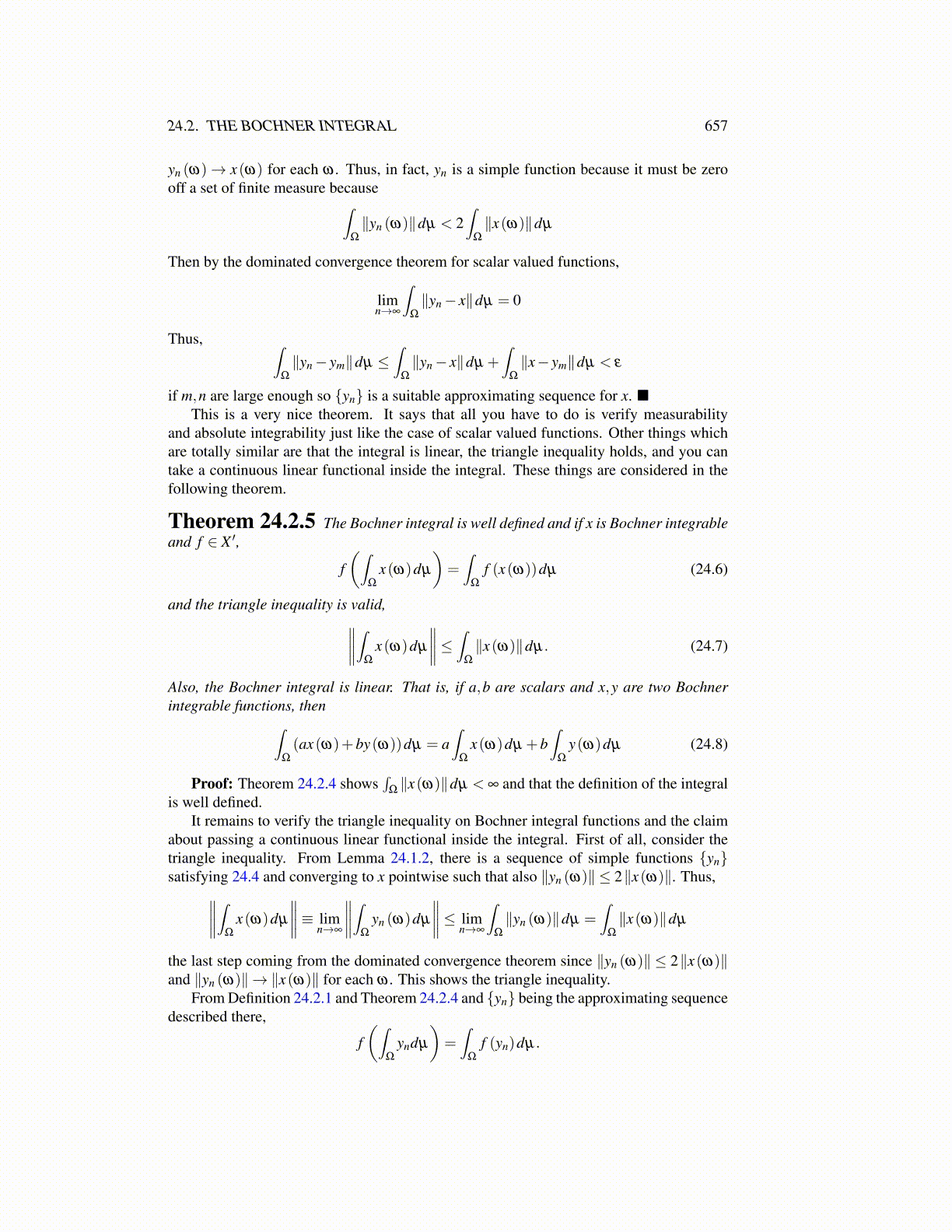
24.2. THE BOCHNER INTEGRAL 657
yn (ω)→ x(ω) for each ω . Thus, in fact, yn is a simple function because it must be zerooff a set of finite measure because∫
Ω
∥yn (ω)∥dµ < 2∫
Ω
∥x(ω)∥dµ
Then by the dominated convergence theorem for scalar valued functions,
limn→∞
∫Ω
∥yn− x∥dµ = 0
Thus, ∫Ω
∥yn− ym∥dµ ≤∫
Ω
∥yn− x∥dµ +∫
Ω
∥x− ym∥dµ < ε
if m,n are large enough so {yn} is a suitable approximating sequence for x. ■This is a very nice theorem. It says that all you have to do is verify measurability
and absolute integrability just like the case of scalar valued functions. Other things whichare totally similar are that the integral is linear, the triangle inequality holds, and you cantake a continuous linear functional inside the integral. These things are considered in thefollowing theorem.
Theorem 24.2.5 The Bochner integral is well defined and if x is Bochner integrableand f ∈ X ′,
f(∫
Ω
x(ω)dµ
)=∫
Ω
f (x(ω))dµ (24.6)
and the triangle inequality is valid,∥∥∥∥∫Ω
x(ω)dµ
∥∥∥∥≤ ∫Ω
∥x(ω)∥dµ. (24.7)
Also, the Bochner integral is linear. That is, if a,b are scalars and x,y are two Bochnerintegrable functions, then∫
Ω
(ax(ω)+by(ω))dµ = a∫
Ω
x(ω)dµ +b∫
Ω
y(ω)dµ (24.8)
Proof: Theorem 24.2.4 shows∫
Ω∥x(ω)∥dµ < ∞ and that the definition of the integral
is well defined.It remains to verify the triangle inequality on Bochner integral functions and the claim
about passing a continuous linear functional inside the integral. First of all, consider thetriangle inequality. From Lemma 24.1.2, there is a sequence of simple functions {yn}satisfying 24.4 and converging to x pointwise such that also ∥yn (ω)∥ ≤ 2∥x(ω)∥. Thus,∥∥∥∥∫
Ω
x(ω)dµ
∥∥∥∥≡ limn→∞
∥∥∥∥∫Ω
yn (ω)dµ
∥∥∥∥≤ limn→∞
∫Ω
∥yn (ω)∥dµ =∫
Ω
∥x(ω)∥dµ
the last step coming from the dominated convergence theorem since ∥yn (ω)∥ ≤ 2∥x(ω)∥and ∥yn (ω)∥→ ∥x(ω)∥ for each ω . This shows the triangle inequality.
From Definition 24.2.1 and Theorem 24.2.4 and {yn} being the approximating sequencedescribed there,
f(∫
Ω
yndµ
)=∫
Ω
f (yn)dµ.